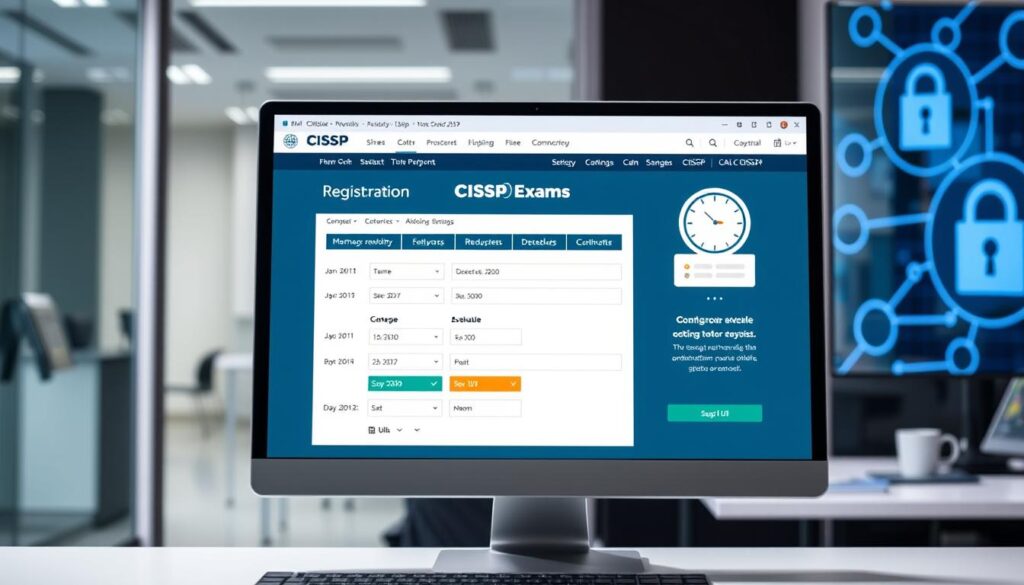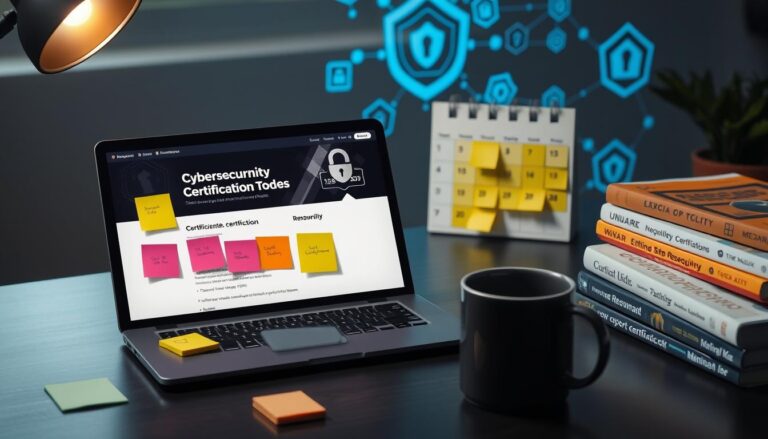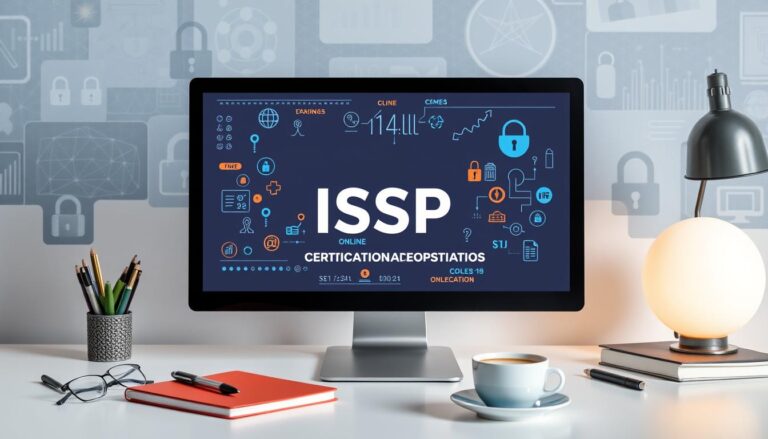
Did you know over 50,000 professionals get their CISSP (Certified Information Systems Security Professional) certification each year? This shows how important the CISSP online exam is in today’s world. It proves you’re dedicated and skilled, helping you move up in your career.
Getting ready for the CISSP online exam is a big challenge. It tests your knowledge in eight key areas. You need about five years of full-time work experience in two or more areas. With a good study plan, the right resources, and focused prep, you can pass on your first try.
In the next parts, you’ll learn about the exam’s structure, why study materials matter, and how to train effectively. You’ll also get tips for exam day. You’re starting a journey that will show your skills and open new doors in cybersecurity.
Introduction to CISSP Certification
The CISSP certification is a top choice in the cybersecurity world. It shows you know a lot about key areas of information security. It’s a sign of trust in the field.
To take the CISSP exam, you need at least five years of work experience. This experience must be in two or more of the eight main domains. These domains are Security and Risk Management, Asset Security, Security Architecture and Engineering, Communication and Network Security, Identity and Access Management, Security Assessment and Testing, Security Operations, and Software Development Security.
Getting this certification can make your resume stronger. It also gives you important skills for managing information security programs. Jobs like Chief Information Security Officer, Security Analyst, and Security Consultant can benefit from it.
The CISSP is recognized and approved by ANAB and ISO/IEC Standard 17024. It’s also approved by the Department of Defense. This shows how important it is in the industry.
Understanding the CISSP Exam Structure
Knowing the CISSP exam structure is key to passing. The exam uses a Computerized Adaptive Testing (CAT) format. This means the questions get harder or easier based on your answers. You’ll face 100 to 150 questions in three hours. To pass, you need at least 700 out of 1000 points.
The CISSP test covers eight main areas of information security. Each area is important and you need to know them well. Here’s a quick look at the domains and how much they count:
| CISSP Exam Domains | Weight (%) |
|---|---|
| Security and Risk Management | 15% |
| Asset Security | 10% |
| Security Architecture and Engineering | 13% |
| Communication and Network Security | 13% |
| Identity and Access Management (IAM) | 13% |
| Security Assessment and Testing | 12% |
| Security Operations | 13% |
| Software Development Security | 11% |
Understanding the CISSP exam format is essential for success. Knowing the exam’s length helps you manage your time. Learning about the different question types and how the exam adjusts will help you stay focused. Make sure to study all domains to cover all the material needed to pass.
The Importance of CISSP Study Materials
Getting ready for the CISSP certification means using many study materials. This ensures you cover all important domains well. The right tools help you understand and remember key concepts for the exam.
Official Study Guides
Official study guides are key to your prep. The ISC2 CISSP Certified Information Systems Security Professional Official Study Guide, Ninth Edition has over 900 practice questions. These questions test your knowledge in all key areas. It also has over 700 electronic flashcards to help you remember important ideas.
Another great resource is the CISSP All-in-One Exam Guide, Eighth Edition. It has over 1,400 practice questions and flashcards. This gives you lots of chances to practice.
Additional Resources
Using different CISSP exam prep resources helps a lot. The Official ISC2 Guide to the CISSP CBK Reference, Fifth Edition lists about 300 objectives across eight domains. It gives focused guidance.
For more practice, check out the ISC2 CISSP Certified Information Systems Security Professional Official Practice Tests, Third Edition. It has 1,300 unique questions in four big practice tests. You can also look into boot camps like Infosec’s, which offers a second try if you fail.
Creating Your CISSP Exam Prep Study Plan
Getting ready for the CISSP exam needs a solid plan. A CISSP exam prep plan tailored to you can really help. First, check what you already know in the eight CISSP domains. This helps you see where you need to focus more.
Plan to study for about 30 days. Spend time on each domain, but also make time for reviewing. A good study schedule is key.
Set aside 90 minutes each day for studying. This adds up to about 45 hours of direct study. After learning, take 1 to 2 weeks for intense practice. Using the Feynman Technique to simplify and explain concepts is a great way to learn.
Also, make sure to practice different types of exam questions. Try to do between 1,500 to 3,500 questions. Start with easier ones and move to harder ones as you get better. Aim to score at least 80% on easy questions and 70-75% on harder ones.
Use a study table like the one below to keep track of your progress:
| Week | Focus Area | Study Hours | Activities |
|---|---|---|---|
| 1 | Security and Risk Management | 12 | Reading materials, practice questions |
| 2 | Asset Security | 12 | Hands-on labs, review |
| 3 | Security Architecture and Engineering | 12 | Video courses, practice tests |
| 4 | Communication and Network Security | 12 | Group study, summarization |
| 5 | Identity and Access Management (IAM) | 12 | Discussion forums, review |
| 6 | Security Assessment and Testing | 12 | Practice questions, expert webinars |
| 7 | Security Operations | 12 | Mock exams, error review |
| 8 | Software Development Security | 12 | Final review, study groups |
| 9 | Review and Practice | 15 | Comprehensive review, focus on weaknesses |
This plan helps you study all areas of the CISSP exam. Check your knowledge often to adjust your focus. Using different study methods keeps your learning fresh and boosts your motivation.
Strategies for Effective CISSP Online Training
Preparing for the CISSP exam needs a mix of methods to study well. Using CISSP online training can make learning easier. It helps you understand complex topics better. Interactive courses and multimedia resources help you remember important information.
Engaging with Online Courses
Online courses help you learn key concepts for the CISSP exam. They include lectures, quizzes, and discussions. This helps you:
- Learn the eight CISSP domains well.
- Use tools like flashcards to master material.
- Get feedback from teachers to improve your weak spots.
Join Study Groups
Being part of CISSP study groups also helps a lot. These groups share knowledge and discuss strategies. Studying with others has many benefits:
- It keeps you motivated with group study sessions.
- It offers support to reduce exam stress.
- It gives you new ideas from others’ experiences.
How to Master the CISSP Exam Format
To ace the CISSP exam, first understand the different types of questions. The exam now has multiple-choice, drag-and-drop, and hotspot questions. These questions test your critical thinking and time management skills.
Practice with sample questions made for the CISSP format. For example, drag-and-drop questions might ask you to sort symmetric cryptography algorithms. Hotspot questions require you to click on specific parts of a diagram to show your knowledge.
Another key strategy is to read each question carefully. Look out for key terms that can help you rule out wrong answers. The exam includes “red herring” questions that test your knowledge with tricky options.
Improving your time management is also vital. Practice pacing yourself to cover all questions. The exam covers eight domains, and knowing these subjects well will help you. The domain weights have changed, with more focus on Security Operations and Software Development Security.
| Domain | Weighting | Change |
|---|---|---|
| Security and Risk Management | 15% | Unchanged |
| Asset Security | 10% | Unchanged |
| Security Architecture and Engineering | 13% | Unchanged |
| Communication and Network Security | 13% | Decreased by 1% |
| Identity and Access Management (IAM) | 13% | Unchanged |
| Security Assessment and Testing | 12% | Unchanged |
| Security Operations | 13% | Unchanged |
| Software Development Security | 11% | Increased by 1% |
Use practice questions that match the exam’s types to prepare. Good exam strategies and mastering the CISSP format will boost your confidence and performance.

CISSP Practice Tests and Their Importance
CISSP practice tests are key to getting ready for the CISSP exam. They mimic the real exam, giving you a feel for the pace and question types. Taking these tests boosts your confidence and helps you learn the material well.
Simulating the Exam Environment
CISSP practice tests help you learn to manage your time. You have about 90 seconds per question, just like the real exam. This practice helps you make fast, smart choices, improving your score.
You can use laptops, tablets, and smartphones for these tests. This makes it easy to study anywhere, anytime.
Identifying Weaknesses
CISSP practice tests also show you where you need to improve. They highlight your strengths and weaknesses in the exam’s different areas. By looking at your results, you can focus on what you need to work on.
ExSim-Max for CISSP, for example, has six practice exams. Users rate it 10/10 for usability. It also offers detailed explanations for right and wrong answers, helping you understand the material better.
Using CISSP practice tests regularly helps you feel more confident and prepared for the exam.
How to Register for the CISSP Online Exam
To register for the CISSP online exam, start by creating an account on the Pearson VUE website. This is where all CISSP exam registrations are managed. You’ll then pick a date and location for your exam based on what’s available.
Make sure you have your ID and any needed documents ready. This includes proof of work experience if required.
The online registration makes it easy to schedule your exam at any time a testing center is open. It’s wise to register early to get the date you want. If you need to change your plans, you can reschedule within 365 days for a $50 fee.

If you need to cancel, expect to pay a $100 fee. Remember, if you miss your exam within 365 days, you won’t get your money back. Companies can save on training costs by buying exam seats in bulk through the ISC2 Voucher Program.
CISSP scheduling is easy to do online at any time. You might even be able to take your exam the same day you register, if seats are available. Don’t forget about support options like the GI Bill, which can help cover exam fees for eligible candidates.
Preparing for Exam Day: Tips and Tricks
Getting ready for exam day can really boost your performance and lower stress. Being well-prepared means you can walk into the test feeling confident and clear-headed. Using pre-exam tips helps avoid last-minute issues and keeps you focused on your goal.
Pre-Exam Checklist
A detailed pre-exam checklist is key for a smooth exam day. Here are some important things to check:
- Make sure your registration with Pearson VUE is correct.
- Bring all needed ID – you must show an acceptable ID.
- Know where your exam is and how to get there, including a test run.
- Use your one free promo code wisely, as it’s only good for that day.
- Take time to review your study materials, but avoid last-minute cramming.
Managing Test Anxiety
It’s important to manage your test anxiety to stay focused. Try these methods:
- Use relaxation techniques like deep breathing or mindfulness to calm down.
- Get enough sleep the night before to help you do your best.
- Remember, a little uncertainty is normal, as 20-25 questions are for the CAT system.
- Reading each question a few times can help you understand it better, as many find it clarifies the question.
- Arrive early at the testing center to stay calm and avoid stress.
By preparing well and managing your anxiety, you’re set for a successful exam day. Use these tips to confidently and effectively tackle your CISSP exam.
CISSP Online Exam: What to Expect
When you take your CISSP exam, you’ll be in a special setting. It’s made to check your cybersecurity knowledge well. Knowing what to expect will make you feel more ready for this big step.
The exam uses Computerized Adaptive Testing (CAT). This means your test might be different from others. You start with questions that are easier, then they get harder based on your answers. You’ll see between 125 to 175 questions if you take the English version. You must answer at least 100 questions, with 25 being practice ones.
How you do on the exam decides what questions you get next. It’s important to answer each question well. Make sure to read all options before choosing the right answer. If you don’t answer 75 questions correctly in 3 hours, you’ll fail.
Getting to know the exam format can help reduce stress and boost your study. The mix of structured questions and thinking tests will greatly influence your experience on that day.
| Exam Format | CISSP CAT Details |
|---|---|
| Cost | US $749 (Asia Pacific, Africa, America, Middle East); EUR €665 (Europe); GBP £585 (UK) |
| Question Range | 125 to 175 questions (English), 250 questions (other languages) |
| Pre-Test Questions | 25 unscored items included |
| Maximum Administration Time | 3 hours |
| Minimum Items to Pass | 75 operational items |
| Exam Languages | English, Chinese, German, Japanese, Spanish |
Conclusion
Passing the CISSP exam is a big step in your cybersecurity career. A well-planned study approach can greatly boost your chances of success. The exam covers eight domains and uses adaptive testing, so you need about 100 to 120 hours of study.
Using official study guides, online courses, and study groups can make a big difference. These tools can improve your learning and practice test scores by up to 20% or more.
Practice exams are key for about 80% of those who pass. They help you get used to the exam format and manage your time well. Knowing about upcoming exam changes can also help you focus your studies.
Every path to CISSP certification is different. Keep refining your study plan and adjust your strategies as needed. Remember, hard work and dedication are key to overcoming this challenge in information security.
Source Links
- How to Pass The CISSP Exam in Your First Attempt
- My Journey to CISSP
- Cybersecurity Exam Tips | CISSP Exam Strategies – CCS Learning Academy
- CISSP – Certified Information Systems Security Professional | ISC2
- Official ISC2 CISSP Online Self-Paced Training – 180-day Materials Access
- CISSP Exam Outline
- Master the CISSP Exam: Schedule, Format, and Scoring Guide
- CISSP resources: Books, practice exams and other study tools [updated 2022]
- I wish I knew all of this before starting my CISSP journey
- CISSP The Easy Way: A 30 Day Plan
- CISSP Tips and Tricks | How to build your CISSP study plan
- CISSP Exam Prep: Developing A Study Plan For Success – BridgingMinds Network
- CISSP Exam Prep: Proven Strategies to Study and Pass with Confidence
- CISSP Exam Preparation Tips: How to Study Effectively
- 8 tips for CISSP exam success in 2025
- Master the New CISSP Exam Format with Sample Questions
- Everything You Need to Know About the 2021 CISSP Exam Changes
- Free Practice CISSP Quiz – CISSP Exam Prep
- CISSP Practice Exam | Boson
- Getting Ready for Your ISC2 Exam
- CISSP Exam Goes Online | Take CISSP Exam Online | Simplilearn
- Get Ready for Exam Day
- My journey on CISSP exam day
- Can You Take the CISSP Exam Online? Latest Insights & Updates
- CISSP Computerized Adaptive Testing
- My Journey to CISSP Certification: How I’m Studying for the CISSP Exam
- How I Passed The CISSP Exam
- CISSP Exam Update (2024): Everything You Need to Know



